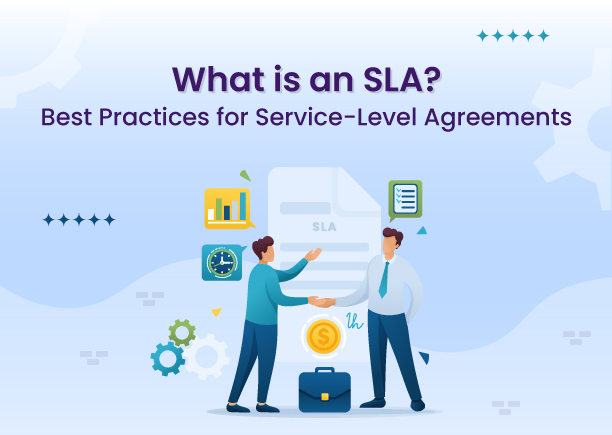Here, you’ll learn about service level agreements (SLAs) and how they benefit companies from wide-ranging industries.
Table of Contents
What is an SLA?
An SLA, or service level agreement, is a contract between a service provider and a customer that specifies the terms of the service being provided. The agreement typically outlines the services to be provided, the level of service to be expected, and the steps to be taken if the agreed-upon service levels are not met
SLAs are often used in business-to-business (B2B) relationships, but can also be found in business-to-consumer (B2C) contracts, such as those between a cable company and its subscribers
Here are a few things to keep in mind:
- Be clear and specific about the services to be provided. It’s important to be as specific as possible about what services will be covered under the agreement. This will help avoid misunderstandings down the road.
- Define what “level of service” means in measurable terms. Again, this is all about avoiding misunderstandings. If you can agree on specific metrics by which the quality of service will be measured, it will be easier to determine.
What Exactly Must be Included in an SLA Management?
- The services to be provided. For example, will the agreement cover email support, telephone support, or both?
- The response time for each type of service. This is one of the most important aspects of an SLA, as it sets expectations for how quickly a problem will be resolved. Be sure to include realistic response times based on your company’s capabilities.
- The uptime guarantee. Uptime is the percentage of time that a system is available, and it’s important to set a realistic uptime goal in your SLA. Otherwise, you risk disappointing customers when problems arise.
- Service credits. Service credits are a way of apologizing to customers when you fail to meet the terms of your SLA. They can be in the form of discounts on future services or even refunds for downtime.
Why a Service Level Agreement is Essential to Business Success?
A Service Level Agreement (SLA) is a formal document that outlines the expectations and mutually agreed-upon levels of service between a service provider and their customer.
There are many different best practices for creating an SLA, but some key elements to consider include:
- Defining what services are covered by the agreement
- Establishing clear targets or benchmarks for service levels
- Setting realistic timeframe for meeting targets
- Outlining specific roles and responsibilities of each party
- Providing mechanisms for review and revision of the agreement
How to Write the Best SLA?
As the business world becomes more competitive, the importance of having a well-drafted and enforceable service level agreement (SLA) is greater than ever. An SLA is a contract between a service provider and a customer that sets out the terms of the service to be provided, including standards, response times, availability, and other factors.
- Define the scope of the agreement. What services will be covered? What is the timeline? What are the geographical boundaries?
- Be realistic in setting expectations. It is important to set achievable goals for both parties in order to avoid disappointment and frustration.
- Use clear and concise language. Avoid technical jargon where possible. The aim is for both parties to be able to understand and adhere to the agreement.
- Make sure all relevant parties have input into the agreement. This includes managers, employees, IT staff, and any other individuals who will be affected by the terms of the agreement.
SLA Examples
- Basic Network Service Level Agreement
- Web Hosting Service Level Agreement
- Software as a Service Level Agreement
- Database as a Service Level Agreement
- Cloud Computing Service Level Agreement
There are several different types of Service Level Agreements (SLAs) that can be used including:
- Block SLAs
- Time and Material SLAs
- Managed SLAs (a form of time and material agreements).
Conclusion
The SLA is a contract between a service provider and a customer that outlines the level of service expected. In order to create an effective SLA, it is important to first understand the needs of the customer and then craft language that will meet those needs.




